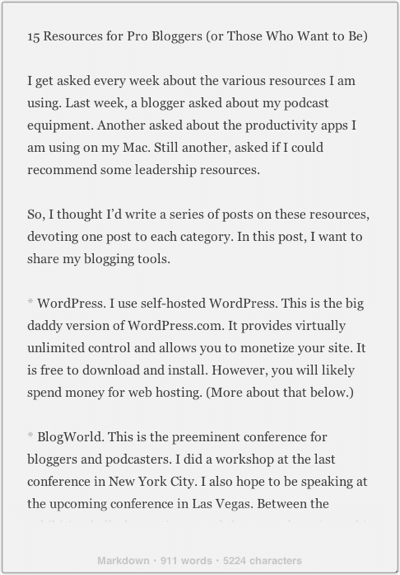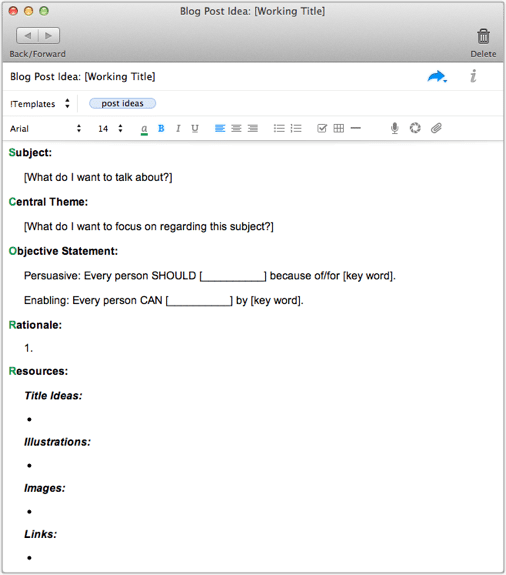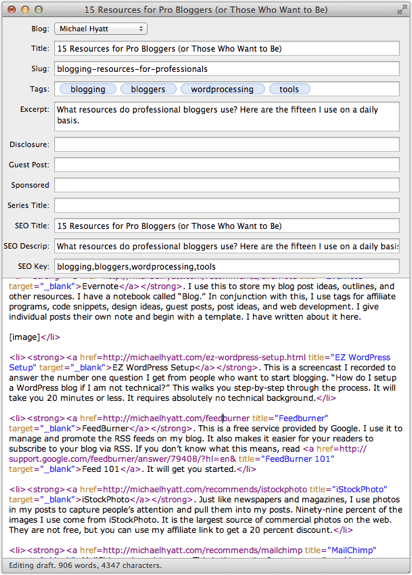I get asked every week about the various resources I am using. Last week, a blogger asked about my podcast equipment. Another asked about the productivity apps I am using on my Mac. Still another, asked if I could recommend some leadership resources.

So, I thought I’d write a series of posts on these resources, devoting one post to each category. When I get done, I plan to collect these into a permanent page on my blog. In this post, I want to share my blogging tools.
Here are my fifteen go-to resources:
- WordPress. I use self-hosted WordPress. This is the big daddy version of WordPress.com. It provides virtually unlimited control and allows you to monetize your site. It is free to download and install. However, you will likely spend money for web hosting. (More about that below.)
- BlogWorld. This is the preeminent conference for bloggers and podcasters. I did a workshop at the last conference in New York City. I also hope to be speaking at the upcoming conference in Las Vegas. Between the exhibition hall, the seminars, and the general sessions, this is a must-attend event.
- BlueHost. There are dozens of web hosting services available. This is the only one I recommend. (Note: I don’t use it for MichaelHyatt.com. My site is so large, I require a dedicated server.) It is easy-to-use, reliable, and inexpensive. It also has superb, 24–7 support.
- BuySellAds. This is the ad network I currently use. It manages all my ad inventory and the payment processing. It requires you to insert some code into your site, but automates everything from there. Advertisers can check your rates, browse your inventory, and make their purchases without your involvement.

- Byword. This is the minimalist word processor I use to write everything. For the record, I am not a fan of Microsoft Word. It is just too bloated and slow for me. It also doesn’t translate well to WordPress. ByWord is simple and fast. It gets out of my way and lets me write. It also uses Markdown language (actually MultiMarkdown), which I use extensively.

- Church Analytics. Some analytics packages provide more information than you can possibly use. Some provide less than you really need. Church Analytics strikes the perfect balance and does this within the context of an interface that is simple, elegant, and powerful. Though I use Google Analytics for advertisers, I use Church Analytics for my daily tracking.
- Evernote. I use this to store my blog post ideas, outlines, and other resources. I have a notebook called “Blog.” In conjunction with this, I use tags for affiliate programs, code snippets, design ideas, guest posts, post ideas, and web development. I give individual posts their own note and begin with a template. I have written about it here.

- EZ WordPress Setup. This is a screencast I recorded to answer the number one question I get from people who want to start blogging. “How do I setup a WordPress blog if I am not technical?” This walks you step-by-step through the process. It will take you 20 minutes or less. It requires absolutely no technical background.
- FeedBurner. This is a free service provided by Google. I use it to manage and promote the RSS feeds on my blog. It also makes it easier for your readers to subscribe to your blog via RSS. If you don’t know what this means, read Feed 101. It will get you started.
- iStockPhoto. Just like newspapers and magazines, I use photos in my posts to capture people’s attention and pull them into my posts. Ninety-nine percent of the images I use come from iStockPhoto. It is the largest source of commercial photos on the web. They are not free, but you can use my affiliate link to get a 20 percent discount.
- MailChimp. This is the service I use to e-mail my blog to my subscribers. It’s free to start and is the most robust service I have found. It gives me near-total control over the output and also provides a very helpful statistics module, enabling me to monitor every aspect of my e-mail campaigns.
- MarsEdit. Once I have my post written in ByWord, I copy and paste the HTML into MarsEdit. I could do this directly into WordPress on the Web, but MarsEdit enables me to do it offline. It also provides a ton of formatting shortcuts, insert images, and schedule posts. Best of all, it connects with ByWord, so I can use them together.

- SnagIt. I use this program for all my screen captures. There are lots of programs that will do this for free. However, this one has some great annotation features and other tools. You can also quickly upload screen captures to the screencast.com website. This is handy for sharing screenshots.
- StandardTheme. Currently, I use a customized version of this premium WordPress theme. It is excellent for a variety of reasons, not the least of which is it’s built-in SEO optimization. Prior to this I used a theme from WooThemes. I also really like the Genesis Framework from StudioPress. (Chris Brogan uses this.) ElegantThemes is also worth checking out.
- W3Schools. This is a reference site where you can find the answer to just about any HTML or CSS question. It provides the syntax and real-world examples. I refer to it almost daily.
I am constantly trying out new tools. This is my list as it stands today.
Disclosure of Material Connection: Some of the links in the post above are “affiliate links.” This means if you click on the link and purchase the item, we will receive an affiliate commission. Regardless, we only recommend products or services we use and believe will add value to our readers. We are disclosing this in accordance with the Federal Trade Commission’s 16 CFR, Part 255: “Guides Concerning the Use of Endorsements and Testimonials in Advertising.








